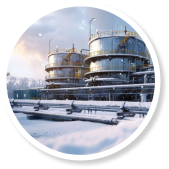https://doi.org/10.15255/KUI.2024.051
Published: Kem. Ind. 74 (7-8) (2025) 335–342
Paper reference number: KUI-51/2024
Paper type: Professional paper
Download paper:  PDF
PDF

Analysis of the Neutralisation Products of Acidic Wastewater from a Phosphogypsum Landfill
K. Mužina, F. Brleković, M. Ercegović, N. Tomas, Z. Ceraj and S. Kurajica
Abstract
Phosphogypsum, a by-product of phosphoric acid and phosphate fertiliser production, is stored in controlled landfills due to its high natural radionuclide levels. The management of these landfills and assessment of their environmental impact are both complex and costly. Atmospheric precipitation generates acidic water, which requires continuous monitoring and neutralisation before being released into the environmental. This process also generates sludge, which accumulates in the landfill. One potential reuse option for phosphogypsum and neutralisation sludge is in the production of organo-mineral fertilisers. This research aimed to test a two-stage neutralisation process for acidic wastewater from phosphogypsum landfills at the Petrokemija Plc. fertiliser plant, using milk of lime. Analysis of all precipitates using energy dispersive X-ray spectroscopy indicated successful removal of fluorine in the first neutralisation stage, the proportion of which in the fertiliser should not exceed 2 wt.%. The first-stage precipitate contained 35.1 wt.% fluorine and 4.2 wt.% phosphorus. The second stage of neutralisation produced a precipitate containing 7.1 wt.% phosphorus, with fluorine not detected. X-ray diffraction analysis determined that the second-stage precipitate consisted mainly of calcite and hydroxyapatite, which are both suitable for use in fertilisers. In the second part of the research, single-stage neutralisation of acidic wastewater using a NaOH solution was analysed as a potentially more cost-effective alternative for landfill maintenance. The high concentration of fluoride in this precipitate limits its reuse in fertilisers, but the significantly lower consumption of NaOH solution for complete neutralisation (8 ml) compared to milk of lime (62 ml) presents a more economical alternative for managing the process.

This work is licensed under a Creative Commons Attribution 4.0 International License
Keywords
phosphogypsum, acidic water, neutralisation, milk of lime, sodium hydroxide









